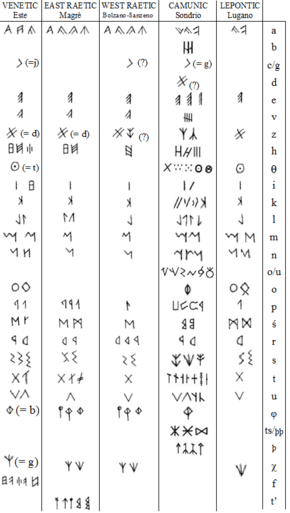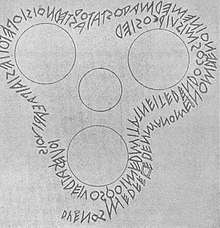Old Italic scripts
The Old Italic scripts are a number of similar ancient writing systems used in the Italian Peninsula between about 700 and 100 BC, for various languages spoken in that time and place. The most notable member is the Etruscan alphabet, which was the immediate ancestor of the Latin alphabet currently used by English and many other languages of the world. The runic alphabets used in northern Europe are believed to have been separately derived from one of these alphabets by the 2nd century AD.
| Old Italic | |
|---|---|
| Type | Alphabet
|
Parent systems | Phoenician
|
| Direction | Left-to-right |
| ISO 15924 | Ital, 210 |
Unicode alias | Old Italic |
Unicode range | U+10300–U+1032F[1] |
Origins
The Old Italic alphabets clearly derive from the Greek alphabet, specifically from the Euboean variant (also known in this case as Cumaean variant) used in the Euboean Greek colonies of Ischia and Cumae in the Bay of Naples in the 8th century BC. The Etruscans were the leading civilization of Italy in that period, and it is assumed that the other Old Italic scripts were derived from theirs – although some of them, including the Latin alphabet, retained certain Greek letters that the Etruscans themselves dropped at a rather early stage.
The Old Italic alphabets were used for various different languages, which included some Indo-European ones (predominantly from the Italic branch, but also in Gaulish and probably in inscriptions interpreted as Proto-Germanic) and some non-Indo-European ones (such as Etruscan itself).
Alphabets related to Etruscan
The following table shows the ancient Italic scripts that are presumed to be related to the Etruscan alphabet. Symbols that are assumed to be correspondent are placed on the same column. Many symbols occur with two or more variant forms in the same script; only one variant is shown here. The notations [←] and [→] indicate that the shapes shown were used when writing right-to-left and left-to-right, respectively. For more information, such as variant shapes and the prevalent writing direction of each script, see the corresponding language article.
Warning: For the languages marked [?] the appearance of the "Letters" in the table is whatever one's browser's Unicode font shows for the corresponding code points in the Old Italic Unicode block. The same code point represents different symbol shapes in different languages; therefore, to display those glyph images properly one needs to use a Unicode font specific to that language.
| Phoenician | ||||||||||||||||||||||||||||||
| Letter [←] | ||||||||||||||||||||||||||||||
|---|---|---|---|---|---|---|---|---|---|---|---|---|---|---|---|---|---|---|---|---|---|---|---|---|---|---|---|---|---|---|
| Value | ʾ | b | g | d | h | w | z | ḥ | ṭ | y | k | l | m | n | s | ʿ | p | ṣ | q | r | š | t | ||||||||
| Western Greek | ||||||||||||||||||||||||||||||
| Letter [→] | ||||||||||||||||||||||||||||||
| Value | a | b | g | d | e | w | zd | h | tʰ | i | k | l | m | n | o | p | s | k | r | s | t | u | ks | pʰ | kʰ | |||||
| Transcription | Α | Β | Γ | Δ | Ε | Ϝ | Ζ | Η | Θ | Ι | Κ | Λ | Μ | Ν | Ξ | Ο | Π | Ϻ | Ϙ | Ρ | Σ | Τ | Υ | Χ | Φ | Ψ | ||||
| Etruscan - from 7th century BC [2][3] | ||||||||||||||||||||||||||||||
| Marsiliana [←] | ||||||||||||||||||||||||||||||
| Archaic (to 5th c.) [←] | ||||||||||||||||||||||||||||||
| Neo (4th to 1st c.)[←] | ||||||||||||||||||||||||||||||
| Value | a | k | e | v | ts | h | th | i | k | l | m | n | p | sh | k | r | s | t | u | ph | kh | f | ||||||||
| Transcription | a | c | e | v | z | h | θ | i | k | l | m | n | p | ś | q | r | s | t | u | φ | χ | f | ||||||||
| Oscan - from 5th century BC | ||||||||||||||||||||||||||||||
| Letter [←] | ||||||||||||||||||||||||||||||
| Value | a | b | g | d | ɛ | v | ts | x? | i | k | l | m | n | p | r | s | t | o: | f | o | e | |||||||||
| Transcription | A | B | G | D | E | V | Z | H | I | K | L | M | N | P | R | S | T | U | F | Ú | Í | |||||||||
| Lepontic - 7th to 5th century BC | ||||||||||||||||||||||||||||||
| Letter [?][→] | 𐌀 | 𐌄 | 𐌅 | 𐌆 | 𐌈 | 𐌉 | 𐌊 | 𐌋 | 𐌌 | 𐌍 | 𐌏 | 𐌐 | 𐌑 | 𐌓 | 𐌔 | 𐌕 | 𐌖 | 𐌗 | ||||||||||||
| Value | ||||||||||||||||||||||||||||||
| Transcription | A | E | V | Z | Θ | I | K | L | M | N | O | P | Ś | R | S | T | U | X | ||||||||||||
| South Picene - from 6th century BC | ||||||||||||||||||||||||||||||
| Letter [?][→] | 𐌀 | 𐌁 | 𐌂 | 𐌃 | 𐌄 | 𐌅 | 𐌇 | 𐌉 | 𐌊 | 𐌋 | 𐌌 | 𐌍 | 𐌏 | 𐌐 | 𐌒 | 𐌓 | 𐌔 | 𐌕 | 𐌖 | 𐌚 | 𐌞 | 𐌝 | 𐌟 | |||||||
| Value | ||||||||||||||||||||||||||||||
| Transcription | A | B | G | D | E | V | H | I | K | L | M | N | O | P | Q | R | S | T | U | F | Ú | Í | * | |||||||
Etruscan alphabet
|
Egyptian hieroglyphs 32 c. BCE
Hangul 1443 Thaana 18 c. CE (derived from Brahmi numerals) |
Various Indo-European languages belonging to the Italic branch (Faliscan and members of the Sabellian group, including Oscan, Umbrian, and South Picene, and other Indo-European branches such as Venetic) originally used the alphabet. Faliscan, Oscan, Umbrian, North Picene, and South Picene all derive from an Etruscan form of the alphabet.
Alphabet of Nuceria
The Nucerian alphabet is based on inscriptions found in southern Italy (Nocera Superiore, Sorrento, Vico Equense and other places). It is attested only between the 6th and the 5th century BC. The most important sign is the /S/, shaped like a fir tree or a fish bone, and possibly a derivation from the Phoenician alphabet.

Missing from the above table:
- Venetic
- Faliscan
- Umbrian
- North Picene
- Rhaetic (Raetic)
- Camunic
Raetic alphabets
The alphabet of Sanzeno (also, of Bolzano), about 100 Raetic inscriptions. The alphabet of Magrè (near Schio), east Raetian inscriptions.
Venetic alphabet
Alphabet of Este: Similar but not identical to that of Magrè, Venetic inscriptions.
Camunic alphabet
Inscribed abecedarium on rock drawings in Valcamonica.
Latin alphabet

21 of the 26 archaic Etruscan letters were adopted for Old Latin from the 7th century BC, either directly from the Cumae alphabet, or via archaic Etruscan forms, compared to the classical Etruscan alphabet retaining B, D, K, O, Q, X but dropping Θ, Ś, Φ, Ψ, and F. (Etruscan U is Latin V; Etruscan V is Latin F.)
| 𐌀 | 𐌁 | 𐌂 | 𐌃 | 𐌄 | 𐌅 | 𐌆 | 𐌇 | 𐌉 | 𐌊 | 𐌋 | 𐌌 | 𐌍 | 𐌏 | 𐌐 | 𐌒 | 𐌓 | 𐌔 | 𐌕 | 𐌖 | 𐌗 |
| A | B | C | D | E | F | Z | H | I | K | L | M | N | O | P | Q | R | S | T | V | X |
South Picene alphabet
The South Picene alphabet, known from the 6th century BC, is most like the southern Etruscan alphabet in that it uses Q for /k/ and K for /g/. ⟨.⟩ is a reduced ⟨o⟩ and ⟨:⟩ is a reduced ⟨8⟩, used for /f/.[4]
Unicode
The Old Italic alphabets were unified and added to the Unicode Standard in March, 2001 with the release of version 3.1. The Unicode block for Old Italic is U+10300–U+1032F without specification of a particular alphabet (i.e. the Old Italic alphabets are considered equivalent, and the font used will determine the variant).
Writing direction (right-to-left, left-to-right, or boustrophedon) varies based on the language and even the time period. For simplicity most scholars use left-to-right and this is the Unicode default direction for the Old Italic block. For this reason, the glyphs in the code chart are shown with left-to-right orientation.
| Old Italic[1][2] Official Unicode Consortium code chart (PDF) | ||||||||||||||||
| 0 | 1 | 2 | 3 | 4 | 5 | 6 | 7 | 8 | 9 | A | B | C | D | E | F | |
| U+1030x | 𐌀 | 𐌁 | 𐌂 | 𐌃 | 𐌄 | 𐌅 | 𐌆 | 𐌇 | 𐌈 | 𐌉 | 𐌊 | 𐌋 | 𐌌 | 𐌍 | 𐌎 | 𐌏 |
| U+1031x | 𐌐 | 𐌑 | 𐌒 | 𐌓 | 𐌔 | 𐌕 | 𐌖 | 𐌗 | 𐌘 | 𐌙 | 𐌚 | 𐌛 | 𐌜 | 𐌝 | 𐌞 | 𐌟 |
| U+1032x | 𐌠 | 𐌡 | 𐌢 | 𐌣 | 𐌭 | 𐌮 | 𐌯 | |||||||||
| Notes | ||||||||||||||||
See also
- Euboean alphabet
- Alphabets of Asia Minor
References
- Old Italic (PDF) (chart), Unicode.
- Giuliano Bonfante (1983). The Etruscan language. Manchester: Manchester University Press. p. 64. ISBN 0719009022. OCLC 610734784. OL 19629507M.
- Herbert Alexander Stützer (1992). Die Etrusker und ihre Welt. Köln: DuMont. p. 12. ISBN 3770131282. LCCN 94191271. OCLC 611534598. OL 1198388M.
- Stuart-Smith, Jane (2004). Phonetics and Philology: Sound Change in Italic. Oxford: Oxford University Press. ISBN 0-19-925773-6.
Further reading
- Bonfante, Giuliano; Bonfante, Larissa (2002). The Etruscan Language: An Introduction (2nd ed.). Manchester: Manchester University Press. ISBN 0-7190-5539-3.
- Mullen, Alex (2013). Southern Gaul and the Mediterranean: Multilingualism and Multiple Identities in the Iron Age and Roman Periods. Cambridge: Cambridge University Press. ISBN 978-1-107-02059-7.
External links
| Wikimedia Commons has media related to Italic letters. |
| Wikimedia Commons has media related to Etruscan alphabet. |
| Wikimedia Commons has media related to Nucerian alphabet. |
| Library resources about Old Italic script |
- "Etruscan Texts Project". U. Mass. Archived from the original on 30 March 2005.
A searchable online database of Etruscan inscriptions
- "Old Italic" (PDF). Unicode.org.
- "The Etruscan alphabet". Omniglot.com.
- "Old Italic alphabets". Omniglot.com.
- "Etruscan". AncientScripts.com.
- "Oscan". AncientScripts.com. Archived from the original on 2015-10-25. Retrieved 2006-11-13.
- "Unicode Fonts". www.wazu.jp.
